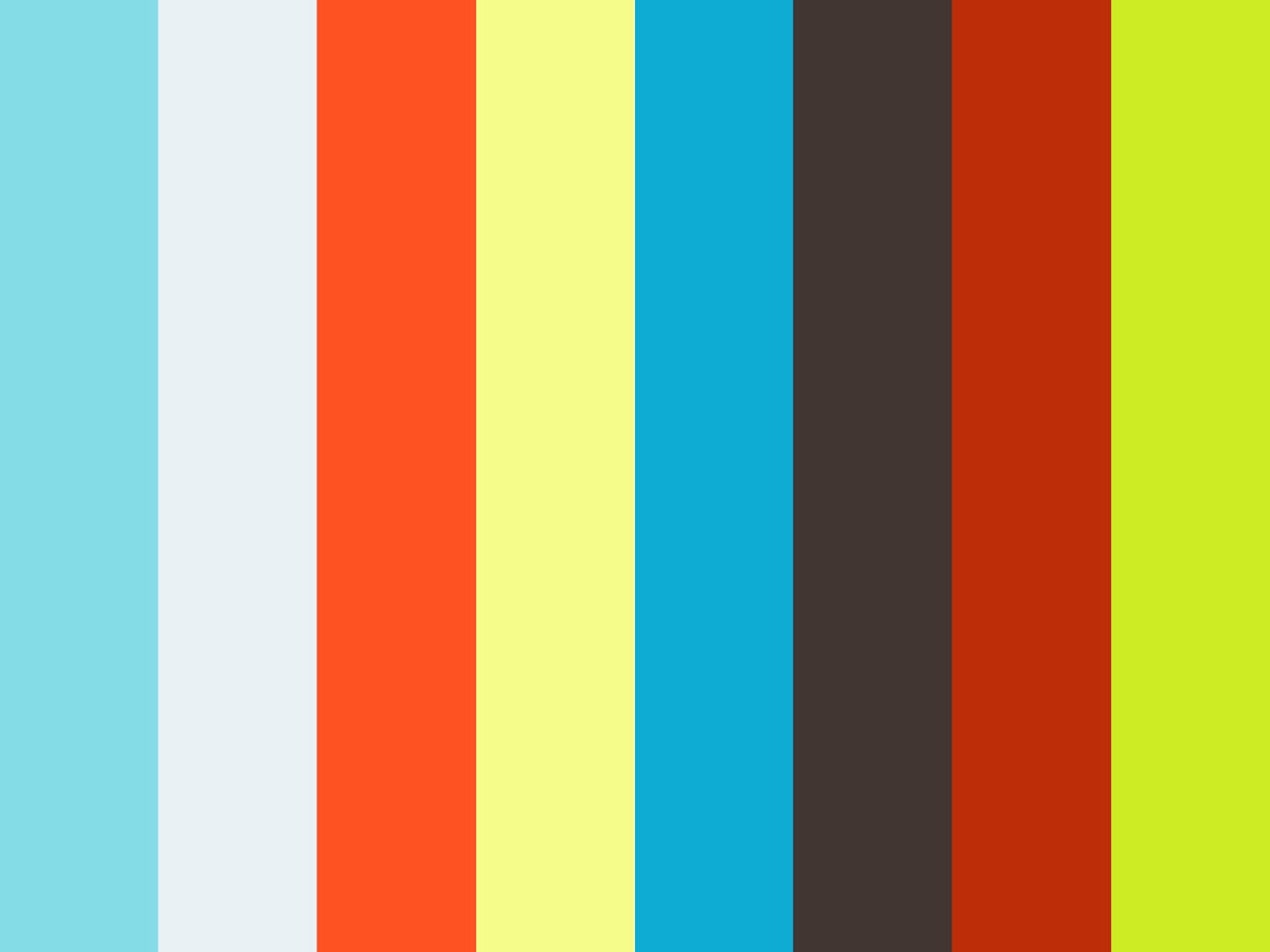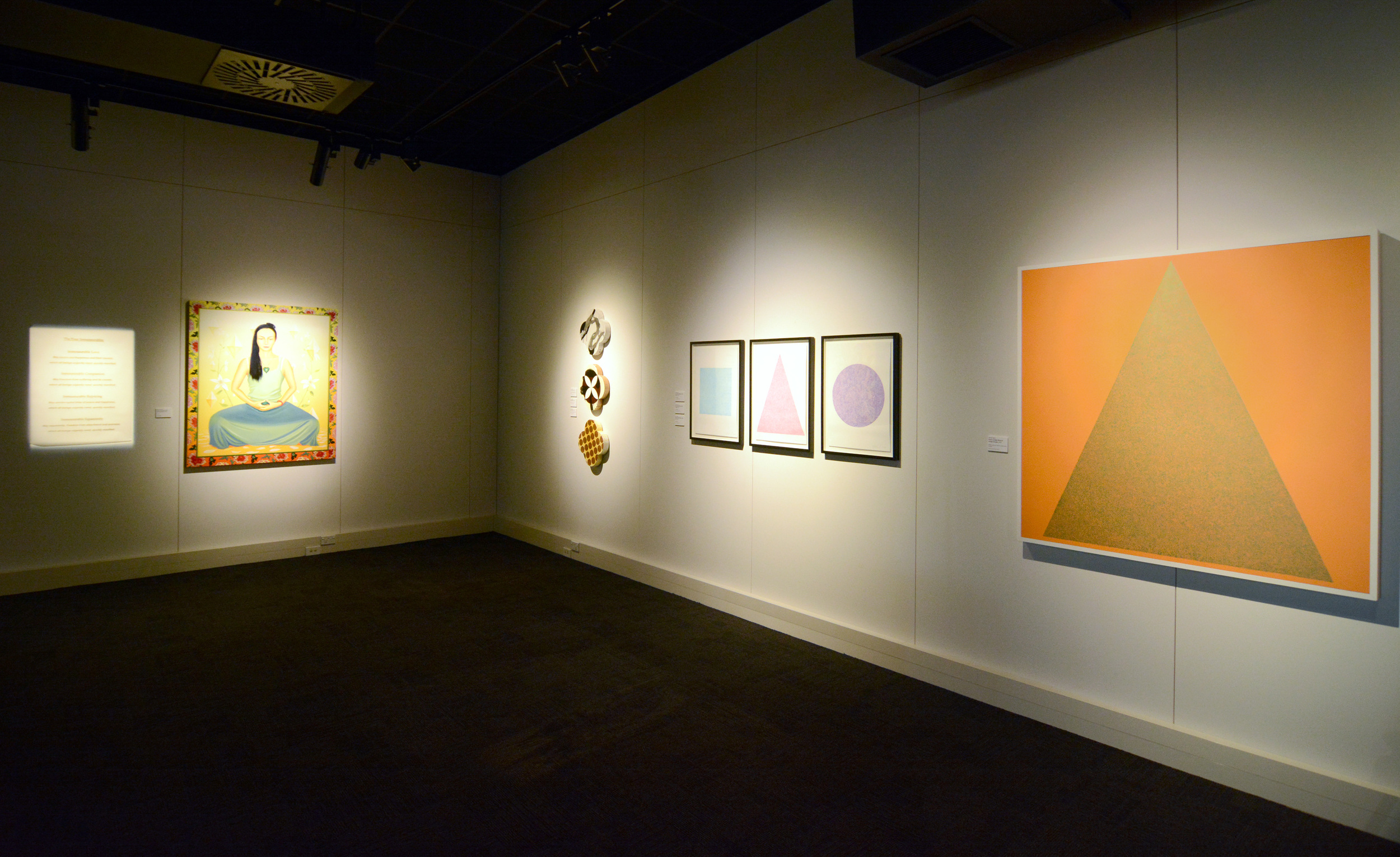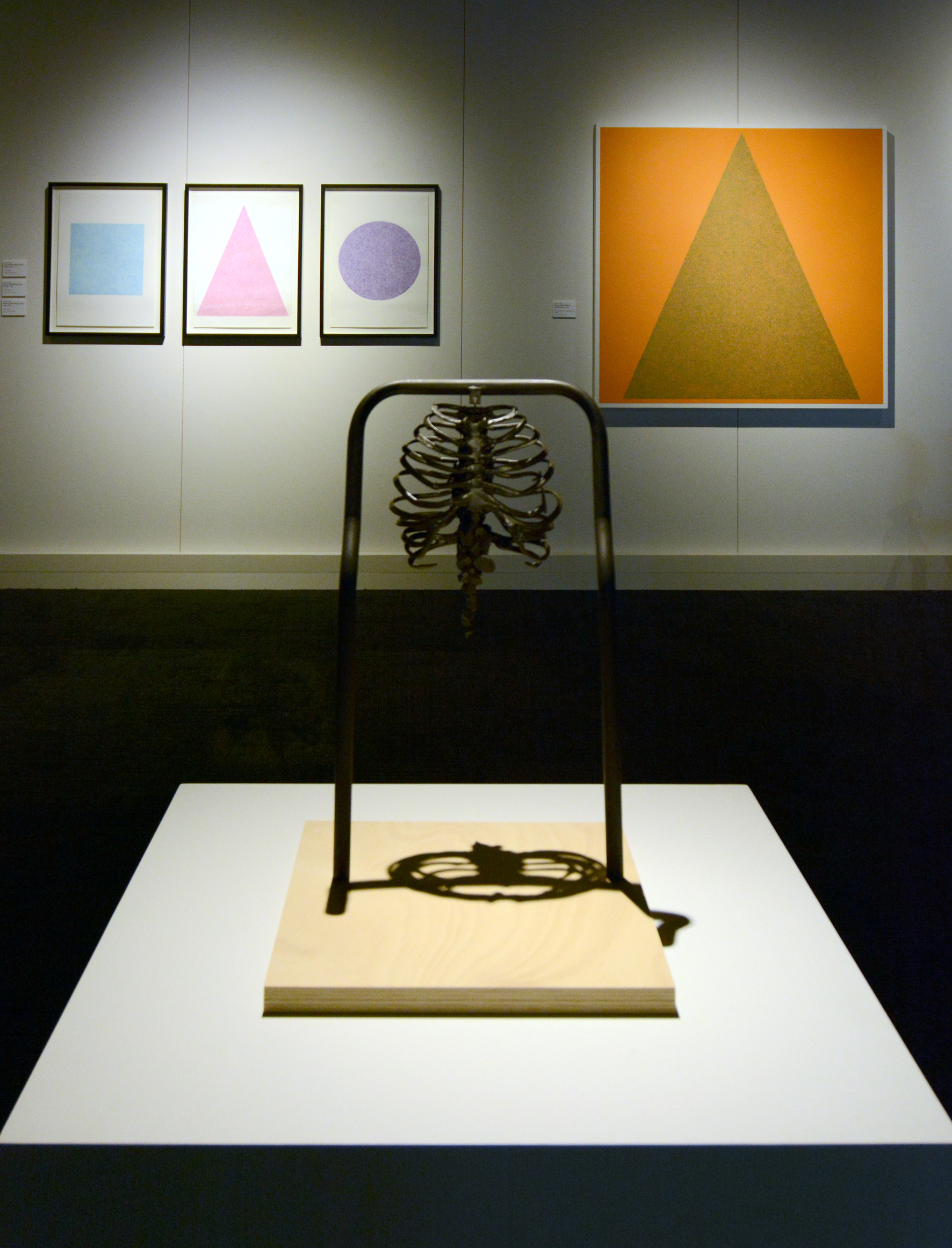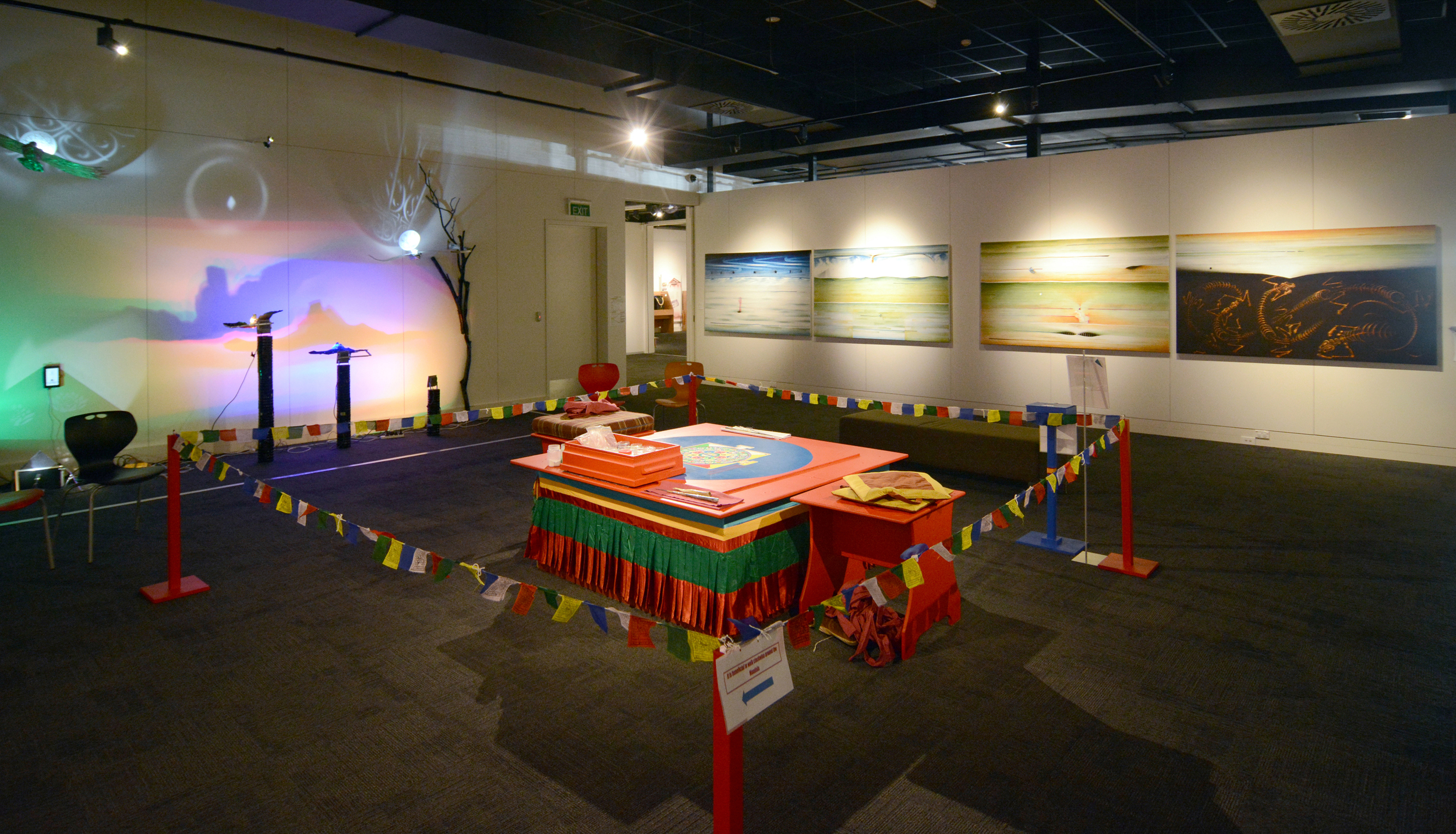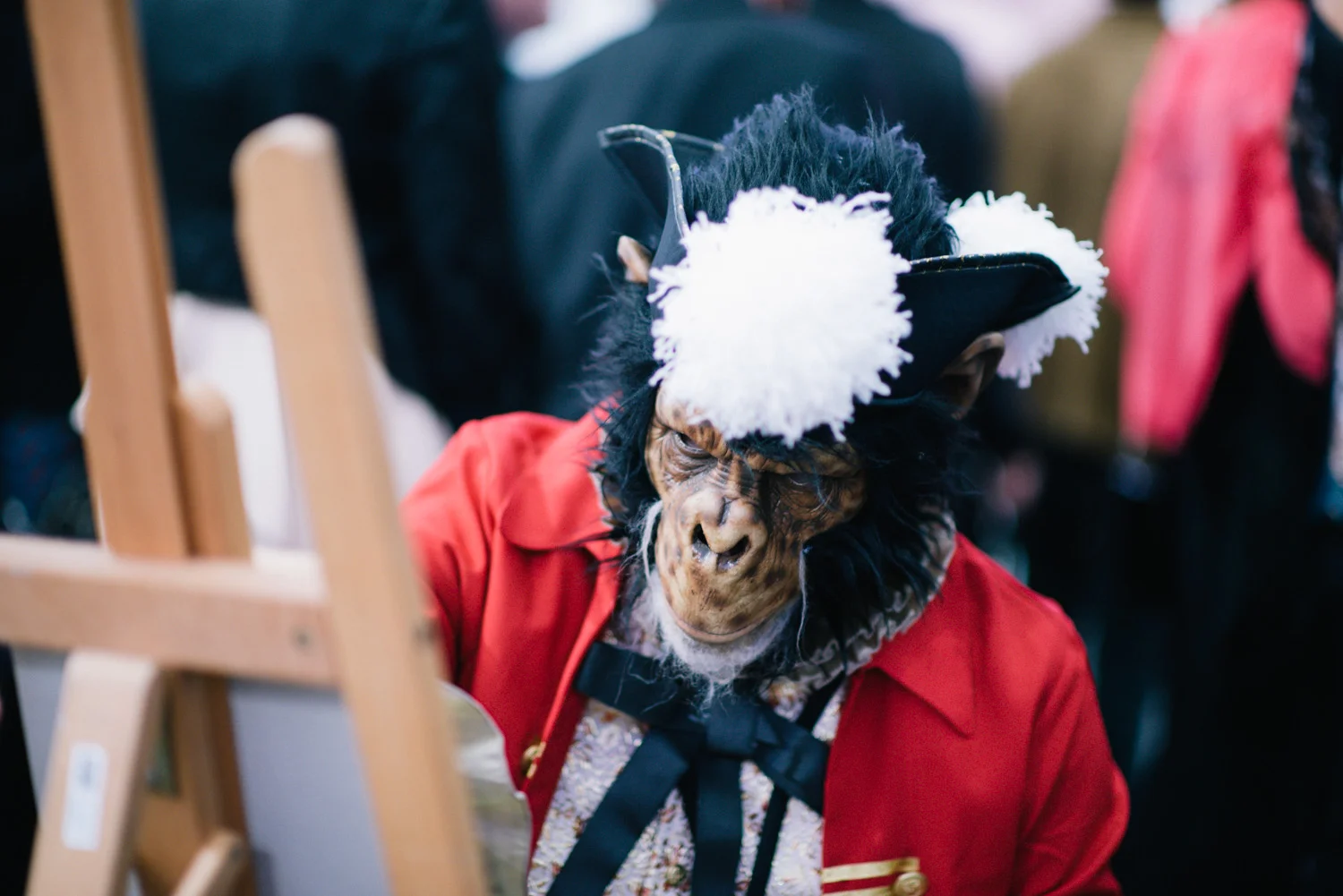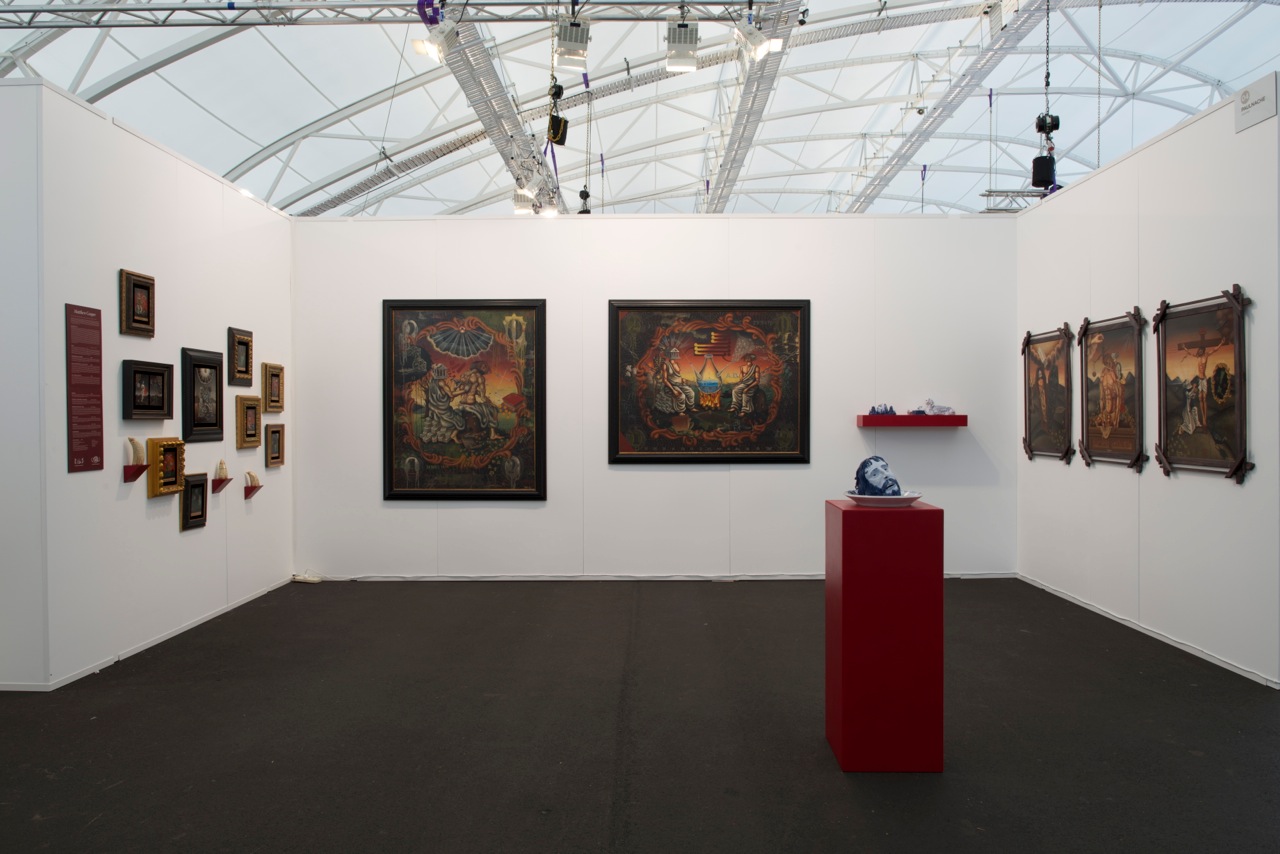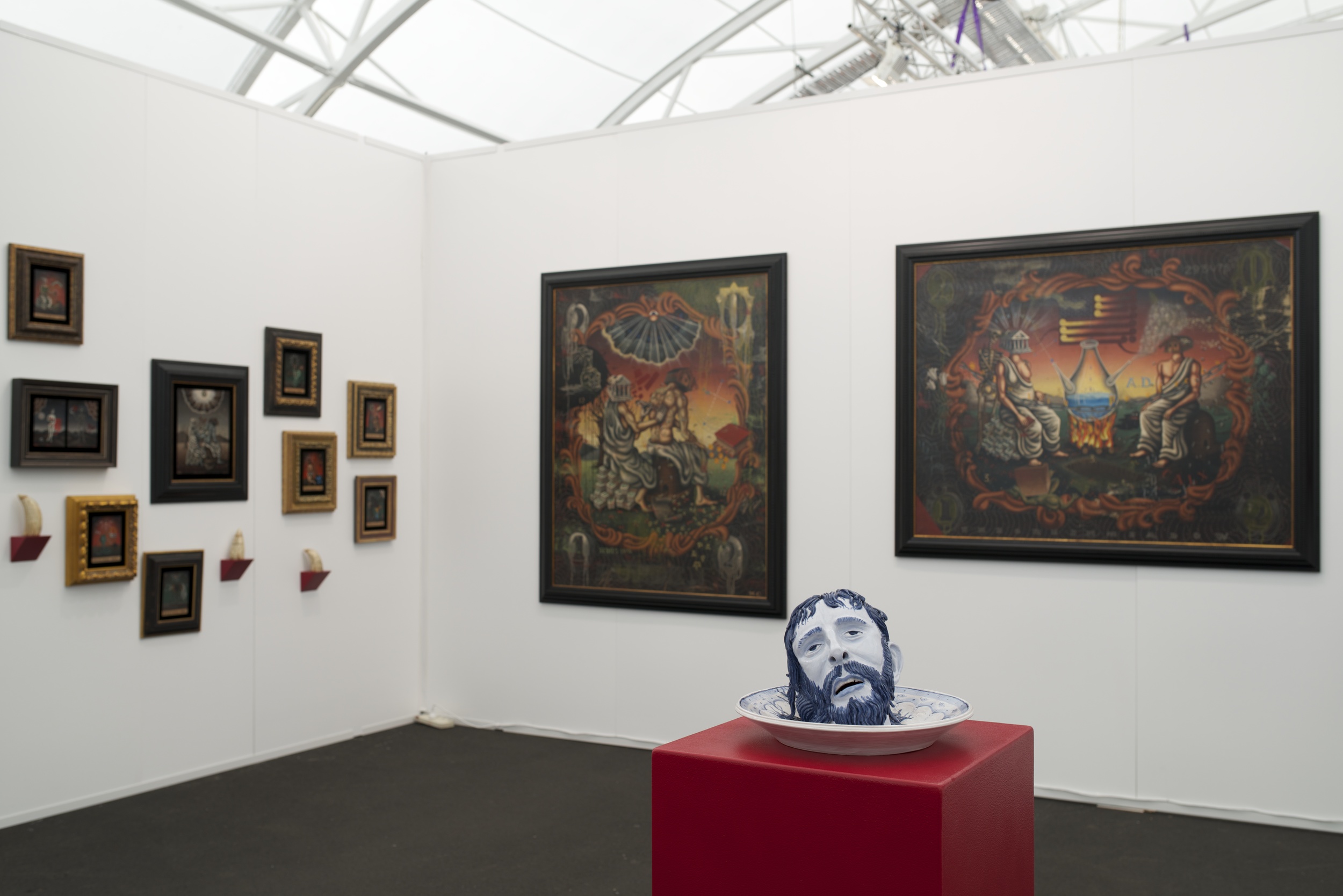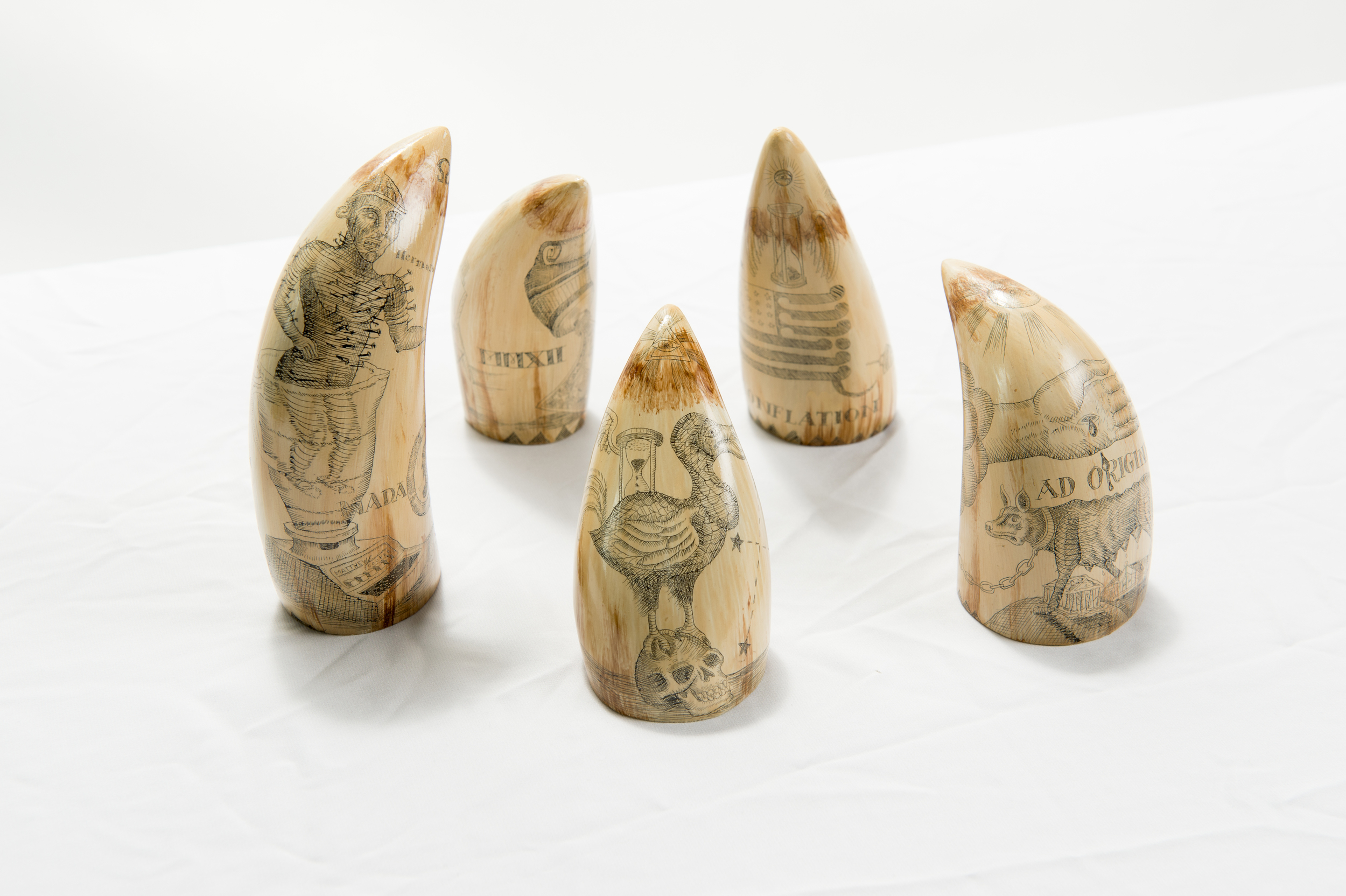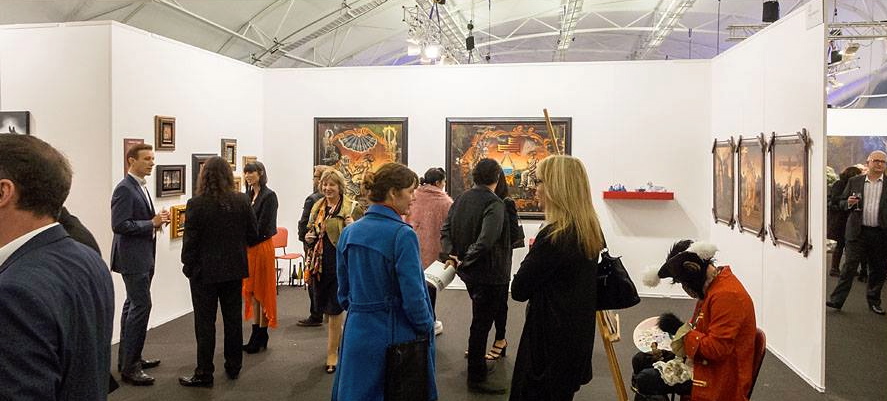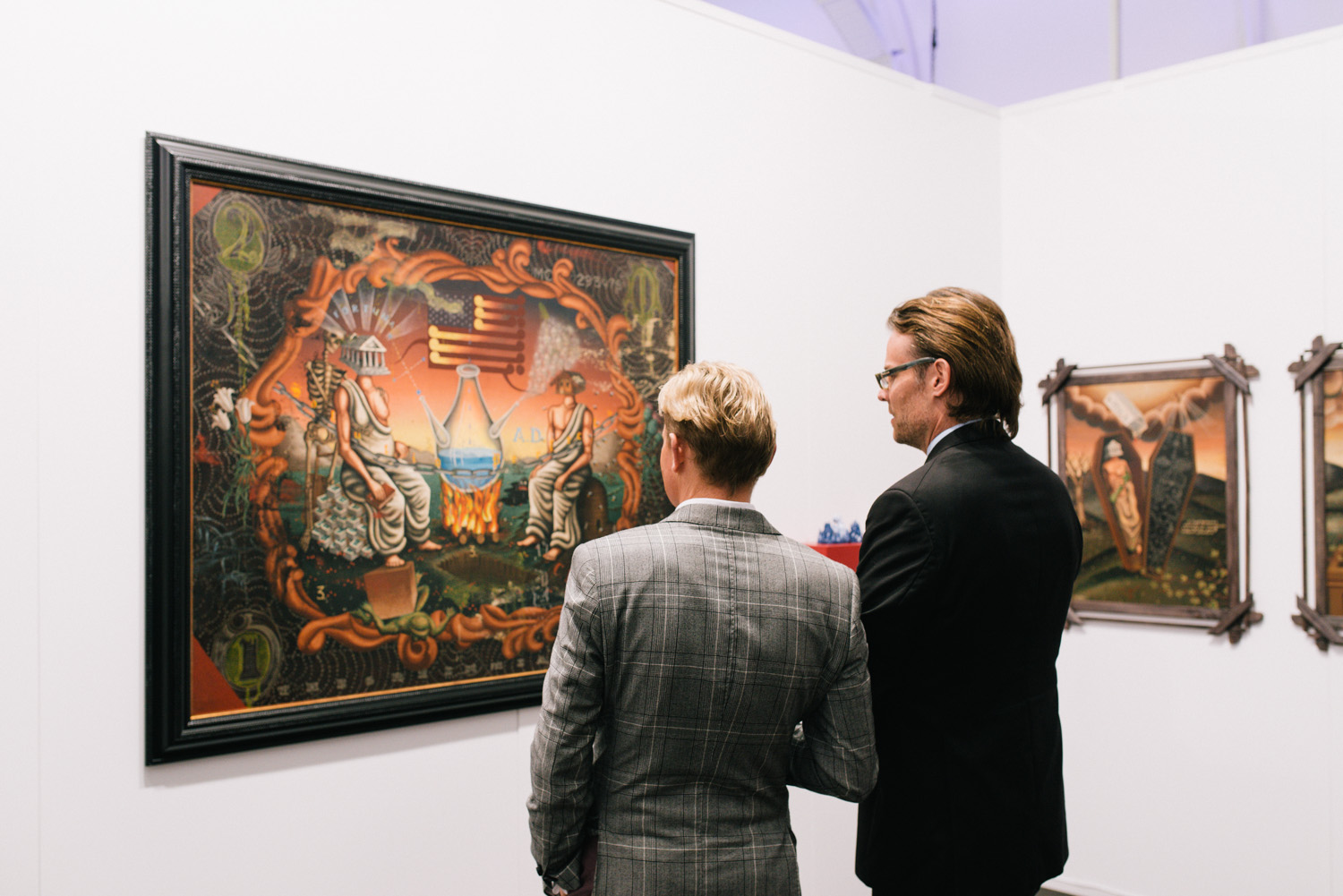As the voyeurs waded around the room, in came the performer. Each person, in being present at the opening, had put themselves in a state of mind specific to that situation. There was a sense of vulnerability at the event that drank the shaken drinks, and climbed the stairs from the road below. We had aligned ourselves with a way of thinking which would evoke others to see us in a certain light. To apprehend the abnormal as if it were simply pedestrian it seems, would qualify us as something different, something greater; perhaps worthy of endemicity. During the opening for the Emperor's New Clothes - curated by James R Ford - Samin Son utilised this vulnerability. He stole the presence of everything in the room and championed the attendees by inducing even more severe anxiety than was felt. Regardless of the degree of each person's openness to Son's presence, he overcame their ego by filling them out with his own.
The room was held to an echo by his chants and throat singing which drew from his experience in the Korean Army, and how any organisation or group that requires hierarchical discipline must overcome egos and marginalise judgement, preconception or pretension. This is done by overriding these feelings with more severe ones of unease or fear to gain control through drills, abuse, discipline and the like. We the audience, who had prepared to behold Son’s performance without surprise, did so to rise to the level of the gallery. Just like soldiers or workers might brace themselves mentally to be able to cope with their regimentation, chasing prestige and ever-higher positions.
One can discern more of Son's ideas through his materials. Each item he wore, used or interacted with related to the themes pertaining to systems of control. With his use of toothpaste, he made a tangible link to his time in the military where the only place for his creativity was on the mirrors with toothpaste during bathroom duty. He also seems to have related to basic everyday aspects of life such as personal hygiene with the toothpaste. Principally, these themes seem impertinent, yet they correlate with dogmatic, belittling systems of surveillance and regimentation. In any given governmental military operations, daily routines are measured to within an inch and a second. Menial tasks are done and redone under a time pressure to ingrain a sense of hierarchy.
Even at the most fundamental level of human action, the soldiers would be scrutinised and room for their personal freedom disparaged to establish control and subservience. With very little margin for personal expression, the individual ideas and beliefs of each soldier would either be quashed, or realigned with the army's way of thinking; So that these lives could be endangered or sacrificed without opposition.
The disparagement of personal freedom persists outside the army, but to a lesser, more subtle degree. Our lives, which are regulated by jobs, schools and ideologies that are overcoded by a market logic, exchange agency for urgency. We fail to recognise, for our preoccupations, what Foucault stated were the three primary techniques of modern “disciplinary” society; hierarchical observation, normalising judgement and the examination.
Similarly, the yellow waterproof suit he donned hints at how, in a broader context, we are controlled on the basis of creating cultures, movements and conventions that causes society to be dependent. We have become more reliant on governments and controlling systems for how we interact physically and emotionally with our world. Consequently, the artist became the martyr of these systems of control by manifesting them completely in his interactions. Meanwhile, he simultaneously embodied the pretensions and apperception he sought to dispel in his military routine by becoming the 'Emperor' of the 'The Emperor's New Clothes'. Thus he unconsciously made reference to a third form of control we are subjected to, being control at the intellectual level.
The nature of art is quite literally infinite in its components and in reality, varied to the point where it is senseless to attempt to derive any one interpretation. Academic concepts of art and truth rely heavily on Humean empiricism and scepticism which is detrimental to any advancement of the notion of art in the intellectual sense. Thus by applying restrictive thought to art we are controlled, limited to a specific view. And since the academic word is accepted as the overriding authority, this conversation of control comes full circle as we then refer back to a hierarchical system.
There came a point in Son’s performance where he used loopers, a microphone and an amplifier to manipulate his voice to engulf the people. It swept low over the floors for a time, then was made to turn up and pierce high, ricocheting off the walls. He would sustain it for so long and so loud that it drove people away from him. The audience were made to be uncomfortable. He pushed them so far from clarity into his own sphere of control. It was he who once during the performance leant over the table where his equipment was, and physically blocked off his creation, his action. How ingratiating it was that the people came to see him but he was an individual, a solitary figure, disjointed and separate from anyone present. His performance began to seem more and more impersonal with the increasingly visceral, harsh tones of his voice and the loudness of the cacophony. Just at the threshold, he restored the room back to a drone. This seemed more comfortable and bearable than when he began. Yet truthfully we had just forgotten, because in the face of such extreme noise and viscera, the original level seemed normal, tolerable. And in a moment, he became white noise. A mild disturbance at most. Almost a pleasant ambience. He allowed us back into the secure realm of our apprehension, and then he and his voice accompanied conversation. This auditory display mimicked how it often takes the application of extreme ideology for people to be tolerant of any level beneath.
Once Son was content that the audience had adjusted, he gathered them up and changed the energy once more. He drew off his coat and hung it from a nail on the wall. He put himself and the fears of the audience up there with it. At this point, the people understood that the performance was coming to a close and they came nearer to see how the artist would terminate the proceedings. The key for Son’s performance to pack a most poignant punch was for the questions he raised to be absolutely and ultimately overriding of any of our own.
“Where”
To close, Son squeezed out that indelible question of identity onto his coat in toothpaste. “Where”. Here he is asking of the audience exactly where they feel the most comfort; Where is it that we might take up our true authentic identity? Here I feel that he is referencing the insipid personal invasion of today which can be partially attributed to the inception of the internet and our monitored interactions bridging the geographical gaps that formerly hindered widespread control.
“Whare”
In the dictatorial style of the performance thus far, Son disregarded his supposed audience, and answered the question for them. With the remainder of the toothpaste, he writes “whare” on the wall above the coat; a compelling way of pointing out the systems of control of the ruling governments, corporations, and organisations such as the media and banking networks. With no need to answer our own questions, with no room for expression, with the only place we might feel natural and organic being the sanctity of our own homes, Son shows us that we are reduced to mindless, consumerist soldiers fighting not for a cause, but against ourselves.
It is important to note that 'whare' means house in Maori. But it comes with greater connotations. It means home, an institution, a place to feel comfortable and a place to meet. This word, while serving to point out control, also functions as a concept that reflects much of Son's selfhood; as both a New Zealander and as a Korean. The Maori term gives context to his upbringing by Kiwi parents in Hastings - small-town New Zealand - since 2001 while simultaneously evincing a link between the colonisation of Aotearoa by the British and the colonisation of Korea by the Japanese. In using the word 'whare' he is giving context to his circumstantial identity, to where he is partially from. This is the beautiful silver lining in Son's piece. A hint of escape despite the alienating allusions made.
The piece is an inward reflection on the machinations of modern controlling systems. Son alludes to organisations and systems that use time, spatial organisation, behavioural manipulation, ideology, surveillance-both explicit in the public arena and implicit in the private dwelling and of the self-economic influence, hierarchy, regimentation and conventions as facets of control. Defacing the structures we build, the clothing we buy and alienating, competing and dominating one another as Son did to each person in the room. He then went back to the sound and slowly wound up the noise to bare and whisper. Then silence.
Hugo Robinson







